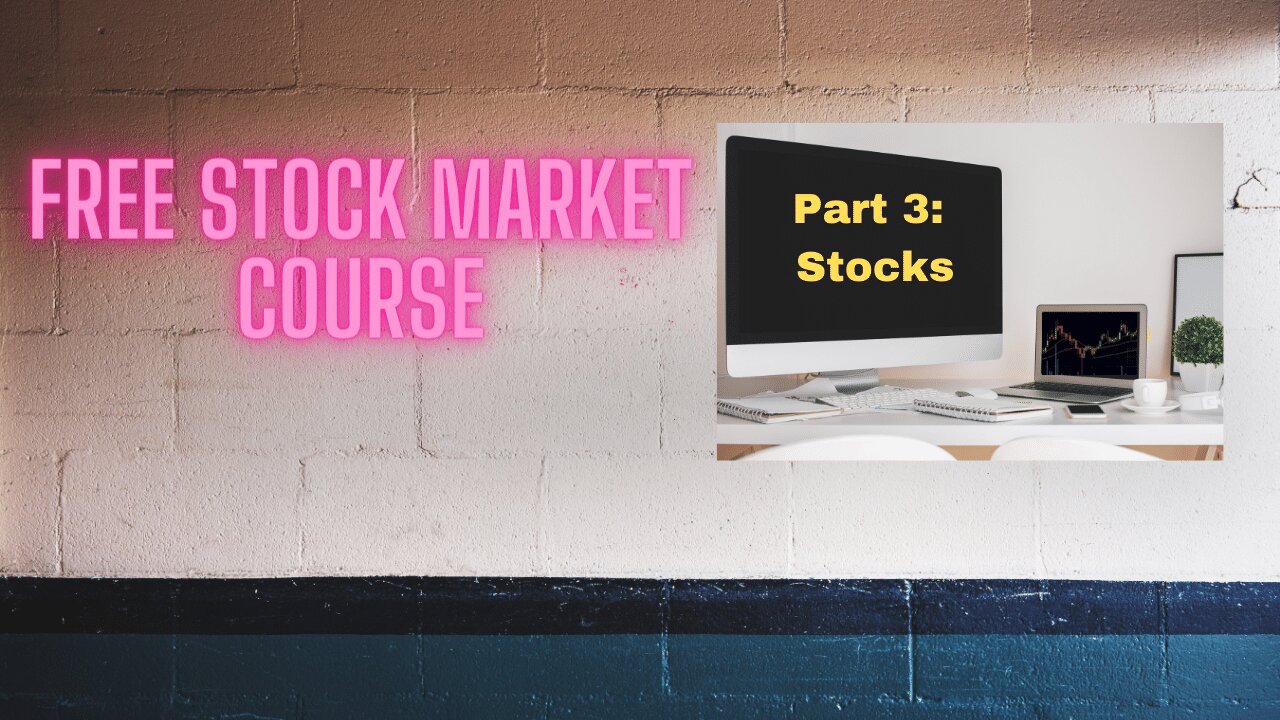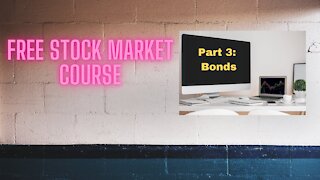Premium Only Content

Free Stock Market Course for Beginners! Part 3 Stocks
Free File downloads
Course notes, Audio files, Assessments, Transcript files, and Course Outline: https://spxinvestingblog.com/downloads/
My Exclusive Free Workshop: The Four P's of Building a Successful Investing Program → https://spxinvesting.mailchimpsites.com
Blog: https://spxinvestingblog.com
Facebook Group: https://www.facebook.com/groups/433843641082343
Chapters:
00:00 What is a Stock?
04:58 Going Public
11:16 Types of Stocks
13:11 Classes of Stocks
17:04 Kinds of Stocks
17:53 Ownership
20:05 Is Going Public a Good Thing?
21:40 Lot
23:57 Stock Exchanges
24:50 New York Stock Exchange NYSE
27:54 NASDAQ
28:54 Which Exchange?
Module 2 Section 2
What is a Stock?
Stock represents ownership of a company.
Stock is created when a company decides to “give away” by selling part ownership of a company.
Stock is also called equity.
A unit of ownership is called a share which fluctuates in value each day.
This is done to raise capital and serve as an incentive for a company to increase profits.
Most companies in the US are “privately held.”
Thousands of companies also have stock that is “publicly traded.”
It is hoped that, over time, the value of the shares, whether public or private, will increase in value.
Going Public
Publicly Traded Company:
A stock that trades on a stock exchange that is open to the public.
Investors and traders with a legal brokerage account can publicly buy or sell shares of a company.
As the company expands or contracts, the stock's price per share is determined by the market.
Stock prices are determined by the forces of:
Supply and Demand
Prices can be influenced by many things, including:
Real Value or Perceived Value
Companies have different types of stock, but for individual investors, the type of stock dealt with most is Common Stock.
When a company first goes public, this is called an Initial Public Offering (IPO).
Types of Stocks
A company can have many different kinds of stock.
Two main types of stock include:
1. Common stock
Voting rights
Dividends
2. Preferred stock
Generally, do not have voting rights,
Usually pay a higher dividend, which is paid before common stock dividends.
Classes of Stocks
Often, a company may have different classes of stock:
Different voting rights
Class A
Class B
Classes can be used to help maintain control.
Different classes can make a company a more difficult takeover target.
Advisor shares:
Given to business advisors for the risk that was taken, insight and expertise.
Company founders or high-level executives.
Compensation for people who helped get the company started or to get it going.
Different classes may exist for load and no-load mutual funds.
Kinds of Stocks
Growth stocks
Dividend stocks
Defensive stocks
Ownership
The more shares owned, the greater the percentage investors own of the outstanding shares.
The property a company owns does NOT belong to shareholders.
Liabilities assumed by a company are NOT the responsibility of shareholders.
Shareholders have no rights to company property.
Ownership gives the right to:
Vote in shareholder meetings,
Receive dividends,
Selling rights.
Is Going Public a Good Thing?
There are advantages and disadvantages to Going Public (IPO)
Advantages:
Raise capital
Pay-down debt
Research and Development (R&D)
Publicity
Disadvantages:
Increased disclosure. Regulated.
Added pressure
Lot
When a stock trades, it typically trades in a Lot.
One lot is 100 shares.
Odd-Lot:
Stock Exchanges
Publicly traded stocks trade on Stock Exchanges.
After an IPO, a stock will trade in the secondary market.
There are many stock exchanges in the US and around the world.
The most famous is the New York Stock Exchange (NYSE).
Other US Stock Exchanges include:
The American Stock Exchange (ASE)
The NASDAQ
New York Stock Exchange (NYSE)
Located on Wall Street in New York, New York, USA.
The NYSE is also known as the “Big Board.”
World’s largest stock exchange:
Combined NYSE market capitalization of $24.5 trillion as of January 2021.
The entire stock market was valued at over $50 trillion as of 12/31/2020.
Daily trading value in 2013: $169 billion
Daily trading volume is about 3.6 billion shares per day as of May 2018.
Founded in 1817
Prior to 1817, stock transactions were done according to the Buttonwood Agreement of 1792.
About 2800 listed companies
Symbols are 1,2,3 letters
NASDAQ
NASDAQ: National Association of Securities Dealers Automated Quotations
The second-largest stock exchange in the world.
Average daily volume of over 5 billion shares
Number of stocks: 3,300
Opened in 1971 to allow for advances in technology to be used.
Most stock symbols have at least four letters.
Which Exchange?
It is not important for most investors and traders to know which exchange a particular stock is traded.
Technology allows for proper routing and tracking.
Arbitrage helps keep prices the same even if one stock trades on different exchanges.
For most investors and traders, all major exchanges are involved.
-
 56:25
56:25
The SPX Investing Program
1 day ago $0.02 earnedS&P 500 Daily Market Update Tuesday December 17, 2024
421 -
 11:44
11:44
The SPX Investing Program
3 years agoFree Stock Market Course for Beginners! Part 4 Bonds
141 -
 12:55
12:55
The SPX Investing Program
3 years agoFree Stock Market Course Part 13: Penny Stocks
145 -
 16:17
16:17
The SPX Investing Program
3 years agoFree Stock Market Course Part 17: Blue Chip Stocks
422 -
 21:15
21:15
The SPX Investing Program
3 years ago $0.01 earnedFree Stock Market Course. Part 6: ETFs
308 -
 34:42
34:42
The SPX Investing Program
3 years agoFree Stock Market Course Part 28: Market Analysis
1022 -
 21:36
21:36
The SPX Investing Program
3 years agoFree Stock Market Course Part 25: Stock Market Orders
160 -
 40:06
40:06
The SPX Investing Program
3 years ago $0.01 earnedFree Stock Market Course Part 15: Forex
203 -
 49:22
49:22
The SPX Investing Program
3 years ago $0.02 earnedFree Stock Market Course Part 14: Cryptocurrencies
2073 -
 19:11
19:11
The SPX Investing Program
3 years agoFree Stock Market Course Part 11: Liquidity
182